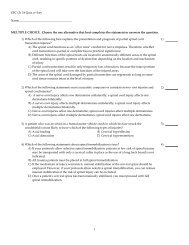EPC, Ch 23 Quiz w-key ...
EPC, Ch 23 Quiz w-key ...
EPC, Ch 23 Quiz w-key ...
You also want an ePaper? Increase the reach of your titles
YUMPU automatically turns print PDFs into web optimized ePapers that Google loves.
8) A growing lesion in the right cranial hemisphere will most likely result in which of the following?A) Normal left pupil; dilated, nonreactive right pupilB) Bilaterally constricted, nonreactive pupilsC) Normal right pupil; dilated, nonreactive left pupilD) Bilateral midpoint, nonreactive pupils8)9) Your patient is a 45-year-old male with extensive blunt trauma to the face. He has decorticateposturing in response to pain; weak, irregular respiratory effort at 6 per minute; and a heart rate of50 with a good radial pulse. The patient appears to have nasal and mandibular fractures, and anoropharyngeal airway is insufficient to keep the tongue from the posterior pharynx. Which of thefollowing has the MOST potential to negatively impact the patient?A) Oral intubation under direct laryngoscopyB) Nasotracheal intubationC) Retrograde intubationD) A nonvisualized dual lumen airway9)10) A closed head injury may present with a set of signs known as Cushing's triad. All of the followingare part of Cushing's triad EXCEPT:A) Slowing pulse. B) Increasing respirations.C) Erratic respirations. D) Increasing blood pressure.10)11) Your patient is a 22-year-old female assault victim. She has blunt trauma to the face with swellingaround the right eye and zygomatic area. Upon assessing her eye movement, you note that theright eye cannot follow your finger and does not move. Which of the following most likely explainsthis finding?A) She has a fracture of the orbit that has trapped the optic nerve, thereby paralyzing her gaze.B) She has direct trauma to the eyeball that has damaged the intrinsic muscles of the eye.C) She has direct trauma to the eyeball that has damaged the optic nerve, thereby paralyzing hergaze.D) She has a fracture of the orbit that has trapped the extrinsic eye muscles.11)12) Which of the following parameters should be used to guide the oxygenation and ventilation of thepatient with a traumatic brain injury?A) Maintain an oxygen saturation level > 95% and a capnography reading < 35%.B) Maintain an oxygen saturation level > 90% and a capnography level < 45 mmHg.C) Maintain an oxygen saturation > 95% and a capnography reading between 35 and 45 mmHg.D) Maintain an oxygen saturation level > 95% and a capnography reading > 45 mmHg.12)13) Central herniation syndrome typically results in which of the following?A) Retrograde amnesia B) Anterograde amnesiaC) Central neurologic hyperventilation D) <strong>Ch</strong>eyne-Stokes respirations13)14) Which of the following medications may be indicated in the prehospital management of the patientwith traumatic brain injury?A) Furosemide B) MethylprednisoloneC) Mannitol D) Diazoxide14)15) You are caring for a 22-year-old amateur boxer who complained of a sudden obstruction of part ofhis visual field. This complaint is most consistent with which of the following conditions?A) Retinal detachment B) Subconjunctival hemorrhageC) Hyphema D) Extrusion of the eyeball15)2



